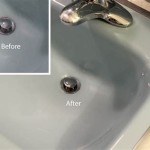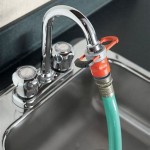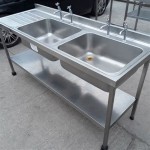35 Inch Vanity With Sink: Optimizing Space and Style
The 35-inch vanity with sink presents a crucial consideration for bathroom design, particularly in spaces where maximizing functionality without compromising aesthetics is paramount. This size category occupies a sweet spot, offering ample storage and countertop area while remaining adaptable to smaller or medium-sized bathrooms. The following discussion explores various aspects of 35-inch vanities with sinks, including their ideal applications, design considerations, material choices, installation factors, and maintenance requirements.
Selecting the correct vanity size is fundamental to creating a comfortable and efficient bathroom. A 35-inch vanity fills a niche between compact units designed for powder rooms and larger, more luxurious vanities suited for master bathrooms. The dimensions are particularly suitable for guest bathrooms, smaller en-suite bathrooms in apartments, or renovated bathrooms where the available footprint is limited.
Beyond the basic size, the configuration of the vanity itself plays a significant role in its usability. Options range from single-door cabinets to multi-drawer units, each with its advantages. The choice depends heavily on the user's storage needs and organizational preferences. Consideration should also be given to the sink style and its impact on storage space. Undermount sinks, for example, typically offer more countertop area but may reduce the available cabinet volume depending on the plumbing configuration.
Furthermore, the style of the vanity should align with the overall design aesthetic of the bathroom. From traditional styles with ornate detailing to modern, minimalist designs, the market offers a wide variety of options. The choice of finish, hardware, and countertop material will further contribute to the overall look and feel of the space.
Optimizing Space and Functionality
The strategic implementation of storage solutions within a 35-inch vanity is crucial, especially given the somewhat constrained dimensions. Drawers are often preferred for organizing smaller items like toiletries, while cabinets can accommodate larger items such as towels and cleaning supplies. The inclusion of adjustable shelves can further enhance the versatility of the storage space.
Furthermore, the internal layout of the cabinet can be customized using organizers and dividers. These accessories can help to maximize the usable space and prevent clutter. Pull-out shelves, for example, can provide easy access to items stored in the back of the cabinet. Door-mounted organizers can also be added to utilize the often-overlooked space on the inside of the cabinet doors.
The design of the sink can also impact the functionality of the vanity. Vessel sinks, for example, sit on top of the countertop, creating a unique aesthetic but potentially reducing the usable countertop space. Undermount sinks, on the other hand, offer a seamless look and maximize the countertop area. Integrated sinks, where the sink and countertop are molded as a single unit, offer a clean and modern aesthetic and can be easy to clean.
Consideration should also be given to the placement of plumbing. Proper planning is essential to ensure that the pipes do not interfere with the storage space. Offsetting the plumbing or using shallow drawers can help to maximize the usable volume within the vanity.
Material Selection and Durability
The materials used in the construction of a 35-inch vanity significantly impact its durability, aesthetics, and overall value. Solid wood, plywood, MDF (Medium-Density Fiberboard), and particleboard are common choices, each with its own set of advantages and disadvantages.
Solid wood is often considered the most durable and aesthetically pleasing option. However, it is also the most expensive and requires careful maintenance to prevent warping or cracking due to moisture. Plywood offers a good balance of strength and affordability. It is more resistant to moisture than solid wood and is typically used for the cabinet frame.
MDF is a cost-effective option that is relatively stable and easy to paint or laminate. However, it is not as durable as solid wood or plywood and can be susceptible to water damage. Particleboard is the least expensive option but is also the least durable. It is highly susceptible to water damage and is generally not recommended for bathroom vanities.
The material used for the countertop is also a critical consideration. Common options include granite, marble, quartz, solid surface, and laminate. Granite and marble are natural stone options that offer a luxurious look and feel. However, they are porous and require sealing to prevent staining. Quartz is a manufactured stone that is durable, stain-resistant, and easy to maintain. Solid surface materials are non-porous and seamless, making them a hygienic and low-maintenance option. Laminate is the most affordable option but is not as durable as the other materials.
The finish of the vanity is also important for both aesthetics and durability. A high-quality finish can protect the underlying material from moisture and wear and tear. Common finish options include paint, stain, and laminate. Paint offers a wide range of color options and can be easily touched up if damaged. Stain allows the natural grain of the wood to show through and provides a warm and inviting look. Laminate is a durable and low-maintenance option that is available in a variety of colors and patterns.
Installation and Maintenance Considerations
Proper installation is crucial for the longevity and performance of a 35-inch vanity. Whether opting for professional installation or a DIY approach, adherence to manufacturer instructions and local building codes is essential. The process typically involves removing the old vanity (if applicable), preparing the plumbing connections, leveling the floor, securing the vanity to the wall, and connecting the sink and faucet.
Before installation, it is important to ensure that the plumbing connections are compatible with the new vanity. This may involve adjusting the placement of the water supply lines and drainpipe. It is also important to ensure that the floor is level to prevent the vanity from rocking or wobbling. If the floor is uneven, shims can be used to level the vanity.
Securing the vanity to the wall is essential for stability. This is typically done using screws or bolts that are attached to the wall studs. It is important to use the correct type of fasteners for the wall material (e.g., drywall, concrete, plaster). Once the vanity is secured, the sink and faucet can be connected to the plumbing lines.
Regular maintenance is essential for keeping a 35-inch vanity in good condition. This includes cleaning the countertop and cabinet surfaces regularly, inspecting the plumbing connections for leaks, and tightening any loose screws or bolts. Spills should be cleaned up immediately to prevent staining. A mild detergent and a soft cloth are typically sufficient for cleaning the countertop and cabinet surfaces. Abrasive cleaners should be avoided, as they can damage the finish.
The plumbing connections should be inspected regularly for leaks. If a leak is detected, it should be repaired immediately to prevent water damage. Loose screws or bolts should be tightened to prevent the vanity from becoming unstable. The hinges and drawer slides should also be lubricated periodically to ensure smooth operation.
In addition to regular cleaning and maintenance, it is important to protect the vanity from excessive moisture. This can be done by ensuring that the bathroom is properly ventilated and by wiping up any spills immediately. A dehumidifier can also be used to reduce the humidity level in the bathroom.
Choosing the right 35-inch vanity with sink requires careful consideration of space constraints, storage needs, design preferences, material options, and installation factors. By carefully evaluating these aspects, it is possible to select a vanity that is both functional and aesthetically pleasing.
Ultimately, the investment in a well-chosen and properly maintained 35-inch vanity can significantly enhance the functionality and visual appeal of a bathroom, providing a practical and stylish solution for years to come.

Unbranded 35 5 In W X 17 7 D H Bathroom Vanity White Solid Frame Cabinet With Ceramic Basin Top Vcw 12233

Blue 35 Inch Wide Bathroom Vanities At Com

The Bella Collection 35 Inch Single Sink White Vanity Base Only

Aoibox 35 5 In W X 17 7 D H Bathroom Vanity Cabinet Gray With Drawers White Ceramic Sink Top Snsa10in028

35 Bathroom Vanity With Tempered Glass Vessel Sink Cabinet W 3 Drawer

35 Floating Bathroom Vanity With Ceramic Vessel Sink Wall Mounted Homary

James In 210 V36 Wlt Li 35 1 2 Bathroom Vanity Qualitybath Com

35 Inch Modern Floating Blue Bathroom Vanity With Sink Homary

Unbranded 35 In W X 17 9 D 33 4 H Bathroom Vanity With Single Sink White Ceramic Top Mad 54

James In 301 V30 Sl 3csp 35 Inch Copper Cove Encore Single Sink Vanity With Charcoal Soapstone Top Silver Gray Keats Castle







